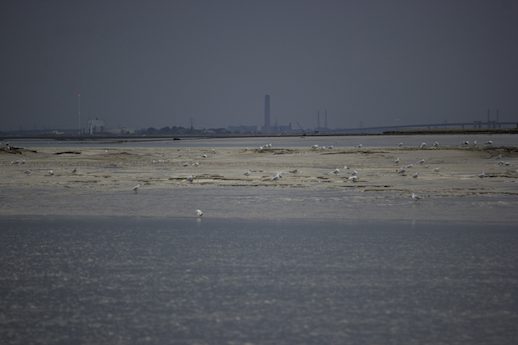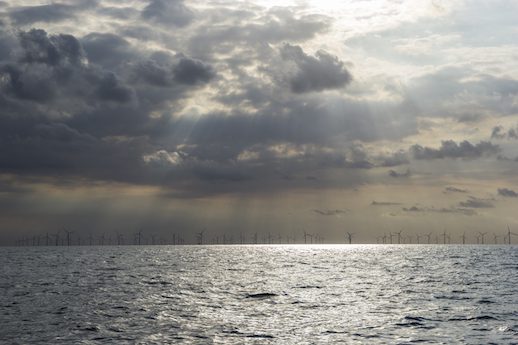Extract from Estuary by Rachel Lichtenstein
Hamish Hamilton, hardcover: 336 pages. 22 September
chapter title – Jacomina
Sailing in the outer reaches
By the time we sailed past London Array on our port side, the sun was shining brightly. The great turbines turned slowly in the wind. Kent became a fine black slither then gradually disappeared altogether. The sea was a perfect mirror, reflecting the sky above. It was incredibly peaceful out there on the edge. We sailed in silence for some time, listening to the hypnotic sounds of the boat gently parting the waves, the halyards tapping against the mast in the wind and water sloshing in and out of the cockpit drains, bubbling up rhythmically before dropping down again.
I found the constant rocking movement of the boat and the ever-changing sea- and sky-scape all around us, with its constantly shifting colours and patterns, extremely meditative and recuperative. Sailing across the great breadth of the Estuary during that long, elastic afternoon, I felt a sense of peace I had not experienced for a long time.
I helmed again for a while, close hauled on starboard tack, follow- ing the wind as it changed, constantly adjusting the wheel to try to achieve an apparent wind angle of forty-five degrees, watching with glee as the telltales on the genoa flew horizontally in the wind. We were heeling gently in a light breeze, travelling at five and a half knots.
We tacked out towards the east, away from the wind farm, laying towards Kentish Knock. There was a clear horizon and good visibility. The sea temporarily turned white-gold ahead, reflecting the bright sky above. Another wind farm loomed in front of us. The radio briefly crackled into life, a French voice came on air for a few seconds then disappeared. A large oil tanker headed south-east into the North Sea, probably going to Rotterdam.
We had been sailing for some hours across the Estuary, over a watery expanse featureless apart from the wind farms, which were ever present. Our skipper checked the charts constantly, relying on them for accurate locations of the long sandbanks stretching out like fingers in all directions. The wind picked up, and we increased our speed to six and a half knots.
In the early evening, just as the sun was beginning to set, we reached a large buoy bobbing on the waves, striped in black and yellow and with a diamond-shaped head topped by a triangular hat with the words ‘Kentish Knock’ in white-and-black letters on the side. Each buoy has its own unique characteristics – some of them have bells, whilst others emit low, mournful sounds created by air being driven through a horn by the waves.
The Kentish Knock buoy was silent as we came alongside, giving no audible warning of the dangers lying beneath: the buoy marks the site of an extremely shallow area of the North Sea bed, where multiple vessels have met their fate over time. During the First Anglo-Dutch War, the English launched a surprise attack on a Dutch fleet of over sixty warships moored there, with devastating consequences. Remnants of this great sea battle probably still lie buried in the Kentish Knock mud, along with the remains of many other vessels, including a German U-boat and a 400-ton nineteenth-century merchant ship called Juliana East Indiaman.
Many merchant ships – hulls creaking, sails billowing – came into the Estuary at this point from the Mediterranean, carrying exotic goods from Europe and beyond. They helped establish sea power in the East Indies, which eventually led to the foundation of the East India Company and the beginning of Britain’s colonization of India. The seventeenth and eighteenth centuries were the Golden Age of the Thames Estuary, when this stretch of water was the major high- way of the British Empire. Tea, silks, opium, salt, cotton and indigo dye flooded into the port of London via the Estuary from all over the world.
We continued sailing north-west towards Harwich. There was no land visible at this point. The sea seemed to fall away from the horizon in every direction, creating the illusion of being in the middle of a giant, circular infinity pool constantly overflowing with water.
We were sailing over Doggerland, a sunken, lost landscape, which was once a vast land mass connecting Britain to mainland Europe during and after the last Ice Age. The outer edges of Dogger Bank sit somewhere near the southern part of Harwich, off the Essex coast and Norfolk, and stretch further north into the North Sea. This pre- historic landscape was gradually flooded by rising sea levels and has now completely disappeared far beneath the sea. Fishermen trawling in the area have recovered remnants of this submerged world, dredging up fossil bones, rhino teeth, mammoth tusks and flint, evidence of great beasts who once roamed that forgotten place.
A single plume of black diesel smoke rose from a tanker in the distance on our starboard quarter. A line of deep crimson sat above the horizon, with great, grey, painterly clouds hanging above. Our skipper pointed out a squall to port, a solid, dark streak in the sky stretching down to the sea, which indicated rain. He could read the landscape around us in ways we could not. He constantly made calculations and adjustments to our route, depending on sea state, water depth, weather, tide and wind.
As the light began to fade from the sky, he prepared us for the night sail ahead, showing us where the torches and the harnesses were and how to tether ourselves to the jack stays that ran along the length of the boat if we needed to move to the bow. I had imagined we would be enveloped in total darkness when the sun finally set, but it happened gently; it was a gradual process. The seascape around us slowly darkened, then faded to black.
A small white light on the mast illuminated the boat just enough for us to be able to see on deck. When the clouds parted, the sky was filled with stars, which were reflected in the water. In the darkness of the night I became acutely aware of the sound of the sea and the continuous rolling of the boat. Sound seemed to take on a different texture; it was sharper, richer and more intense somehow. I stood at the helm, watching the wake of the boat in the murky sea behind, which occasionally became luminescent in the water. In the far distance, out in the North Sea, the water merged with the horizon, and there was only blackness.
Pre-order a copy of Estuary from the Caught by the River shop.

